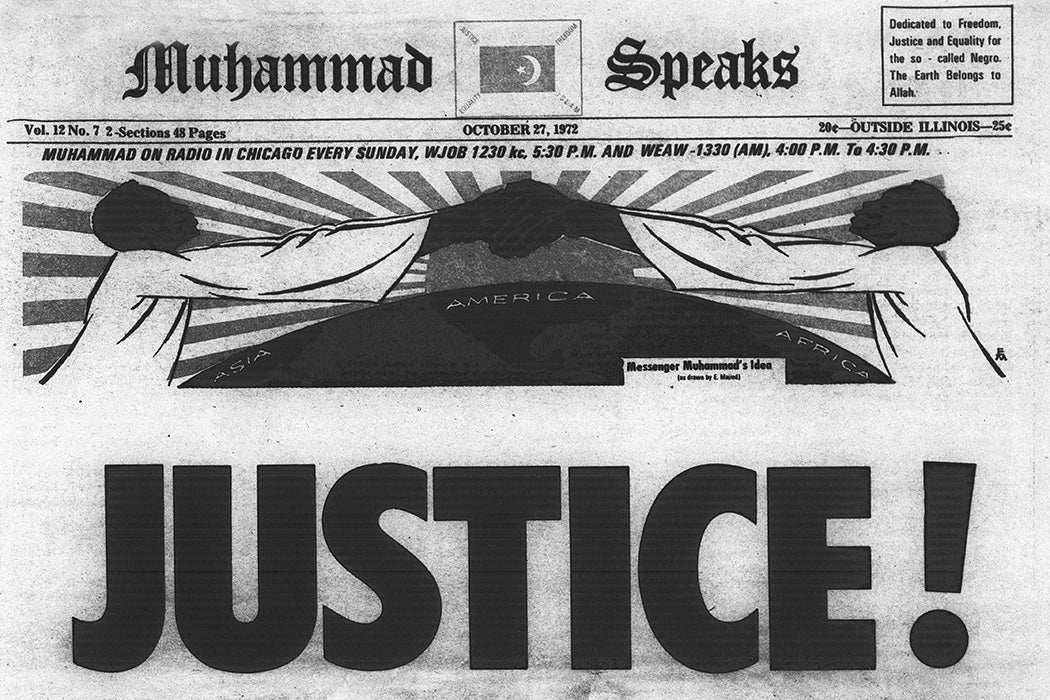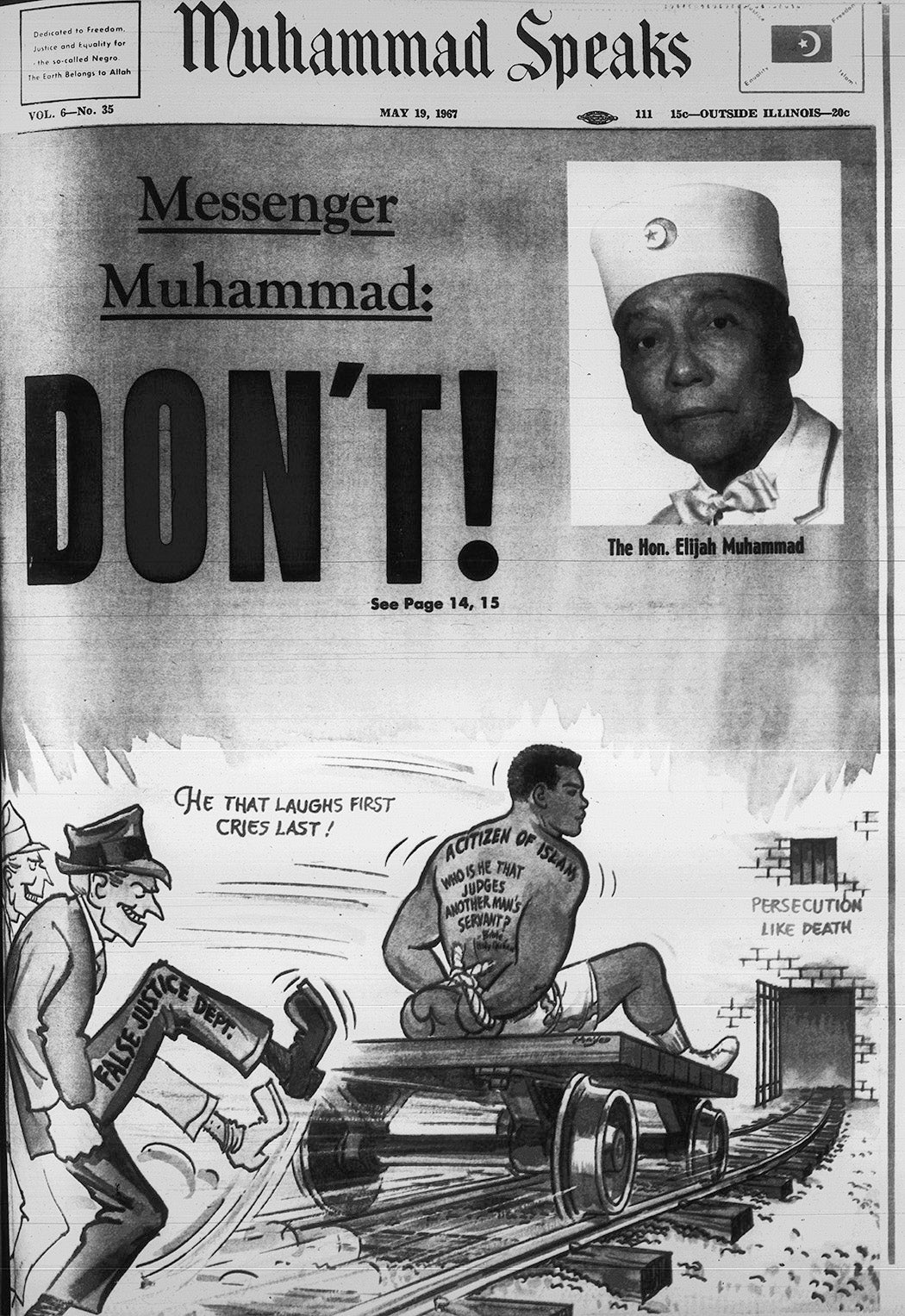get these nets
Veteran
Open Community Collections
Muhammad Speaks for Freedom, Justice, and Equality
The official newspaper of the Nation of Islam—published from 1960-1975—combined investigative journalism and Black Nationalist views on racial uplift.

From the cover of Volume 12, Issue 7 of Muhammad Speaks
May 13, 2021
During the late 1960s, Muhammad Speaks was the most widely-circulated Black-operated newspaper in the United States. While it is often associated with the fiery images and ominous messaging of its front covers, it was far more than a sensationalist tabloid. Its combination of community-oriented investigative journalism and Black Nationalist views on racial uplift made it a distinct voice in Black communities for news and commentary. It served as an important source of information for civic leaders, and grassroots organizers, like CORE and the NAACP, as well as those surveilling Black communities such as the FBI and the Ku Klux Klan.
In 1960, the National Minister of the Nation of Islam, Malcolm X, published the first edition of a Harlem-Based newspaper titled Mr. Muhammad Speaks. It was a tabloid-sized city paper dubbed a “militant monthly dedicated to Justice for the Black Man.” Malcolm X enlisted professional Black writers and journalists to gather news, write stories, and edit galley proofs. The paper printed the teachings of the Honorable Elijah Muhammad, the leader of the Nation of Islam, and covered major racial justice issues of the day, with an eye towards both domestic and international struggles against racism and colonialism.
In 1961, the paper moved to Chicago, shortened its name to Muhammad Speaks and began national circulation, as a weekly paper, with a larger staff of writers, editors, and illustrators. The paper stood out for its colorful language, striking illustrations, as well as its layout and quality of writing about Black communities. Male members of the Nation of Islam hawked the paper on bustling urban street corners, calling Black passersby to “come back to your own” and “read Muhammad Speaks.”
One of Muhammad Speaks’ most distinctive attributes was the juxtaposition of religious and secular content.
Aggressive street sales and a focus on Black communities made the paper a familiar feature in urban Black centers across the United States. Muhammad Speaks’ reporters established relationships with communities by obtaining local perspectives and following up on a story several weeks or months later. According to editor-in-chief Leon Forrest, journalists were “nourished and accredited” by Black communities, reporting on bad housing, rent strikes, tutorial programs, drug epidemics, and employing vets returning from Viet Nam. Such reporting earned the paper a reputation as a viable news source among community leaders such as mayors, city councilpersons, and grassroots organizers, such as local NAACP and Urban League offices. Hundreds of editorials attest to the reception of the paper’s news coverage. In a 1973 letter to the editor, college student Eugene Lassier offered his “sincerest felicitations” on the “splendid and informative newspaper” which Lassier described as an “education in itself.” The presence of local business advertisements further demonstrate the community relevance of the paper. Ads for a local jewelry repair shop in Chicago, a perfume shop in Cleveland, or a bakery in Harlem filled the advertisement pages. Hundreds of mom-and-pop Black businesses, in small and large cities, bought ad space in the national paper as though it were a local city paper, despite the fact that there were no city editions!
One of Muhammad Speaks’ most distinctive attributes was the juxtaposition of religious and secular content. The cover often depicted the image of Elijah Muhammad, the religious leader of the Nation of Islam, and its pages invariably featured religious content, including a centerfold dedicated to the speeches and teachings of Muhammad. Alongside these messages was coverage and commentary on domestic and international events by secular journalists and writers unaffiliated with the Nation of Islam. Editor-in-Chief John Woodford paralleled the approach of papers like the Christian Science Monitor that routinely include a designated space for religious messaging. Unlike the Monitor, however, the presence of religious exaltations were also present in Muhammad Speaks’ cartoons, editorials, and updates. This juxtaposition put on full display a diversity of viewpoints from Black Nationalists, progressives, and leftists.

A cartoon illustrating the trial of Muhammad Ali in Volume 6, Issue 35 via JSTOR
The scope of ideas in Muhammad Speaks were colorfully depicted through illustrations. Virtually every edition of the nearly 700 issues of Muhammad Speaks included vivid and pointed political cartoons that analyzed current events from the point of view of Black Nationalists and progressives. The illustrations proved an effective medium for communicating leftist politics and Black Nationalist perspectives on domestic and international events. Created by professional graphic designers, illustrators, and artists the cartoons delivered a sophisticated visual commentary on every major stage of the Black freedom struggle of the1960s and 70s. From the struggle for civil rights, to Black protest against the war in Viet Nam, and the rise of African independence movements, Muhammad Speaks’ cartoons provided a distinct view of events impacting the lives of Black Americans. Eugen Majied’s original artwork, in particular, became iconic among depictions of the Black freedom struggle. From illustrations of the March on Washington to the trial of Muhammad Ali, Majied’s artwork continues to impact how we see and understand the civil rights era.
On October 24, 1975 Muhammad Speaks published its final issue, heralding Bilalian News as its successor. The renaming was part of a larger sea change in the Nation of Islam, following the death of Elijah Muhammad and the ascent of his son W.D. Muhammad to the helm of the Nation of Islam. While Bilalian News remained a community-oriented press that editorialized national events, its focus shifted towards faith-based activities and away from investigative journalism.
Throughout its 15-year run, Muhammad Speaks translated every stage of the Black freedom struggle through the ideals and aspirations of Black Americans who sought a way to freedom beyond the path of traditional civil rights activism. In the process they evoked controversy and highlighted the multiplicity of liberation struggles in Black communities
Muhammad Speaks for Freedom, Justice, and Equality
The official newspaper of the Nation of Islam—published from 1960-1975—combined investigative journalism and Black Nationalist views on racial uplift.

From the cover of Volume 12, Issue 7 of Muhammad Speaks
May 13, 2021
During the late 1960s, Muhammad Speaks was the most widely-circulated Black-operated newspaper in the United States. While it is often associated with the fiery images and ominous messaging of its front covers, it was far more than a sensationalist tabloid. Its combination of community-oriented investigative journalism and Black Nationalist views on racial uplift made it a distinct voice in Black communities for news and commentary. It served as an important source of information for civic leaders, and grassroots organizers, like CORE and the NAACP, as well as those surveilling Black communities such as the FBI and the Ku Klux Klan.
In 1960, the National Minister of the Nation of Islam, Malcolm X, published the first edition of a Harlem-Based newspaper titled Mr. Muhammad Speaks. It was a tabloid-sized city paper dubbed a “militant monthly dedicated to Justice for the Black Man.” Malcolm X enlisted professional Black writers and journalists to gather news, write stories, and edit galley proofs. The paper printed the teachings of the Honorable Elijah Muhammad, the leader of the Nation of Islam, and covered major racial justice issues of the day, with an eye towards both domestic and international struggles against racism and colonialism.
In 1961, the paper moved to Chicago, shortened its name to Muhammad Speaks and began national circulation, as a weekly paper, with a larger staff of writers, editors, and illustrators. The paper stood out for its colorful language, striking illustrations, as well as its layout and quality of writing about Black communities. Male members of the Nation of Islam hawked the paper on bustling urban street corners, calling Black passersby to “come back to your own” and “read Muhammad Speaks.”
One of Muhammad Speaks’ most distinctive attributes was the juxtaposition of religious and secular content.
Aggressive street sales and a focus on Black communities made the paper a familiar feature in urban Black centers across the United States. Muhammad Speaks’ reporters established relationships with communities by obtaining local perspectives and following up on a story several weeks or months later. According to editor-in-chief Leon Forrest, journalists were “nourished and accredited” by Black communities, reporting on bad housing, rent strikes, tutorial programs, drug epidemics, and employing vets returning from Viet Nam. Such reporting earned the paper a reputation as a viable news source among community leaders such as mayors, city councilpersons, and grassroots organizers, such as local NAACP and Urban League offices. Hundreds of editorials attest to the reception of the paper’s news coverage. In a 1973 letter to the editor, college student Eugene Lassier offered his “sincerest felicitations” on the “splendid and informative newspaper” which Lassier described as an “education in itself.” The presence of local business advertisements further demonstrate the community relevance of the paper. Ads for a local jewelry repair shop in Chicago, a perfume shop in Cleveland, or a bakery in Harlem filled the advertisement pages. Hundreds of mom-and-pop Black businesses, in small and large cities, bought ad space in the national paper as though it were a local city paper, despite the fact that there were no city editions!
One of Muhammad Speaks’ most distinctive attributes was the juxtaposition of religious and secular content. The cover often depicted the image of Elijah Muhammad, the religious leader of the Nation of Islam, and its pages invariably featured religious content, including a centerfold dedicated to the speeches and teachings of Muhammad. Alongside these messages was coverage and commentary on domestic and international events by secular journalists and writers unaffiliated with the Nation of Islam. Editor-in-Chief John Woodford paralleled the approach of papers like the Christian Science Monitor that routinely include a designated space for religious messaging. Unlike the Monitor, however, the presence of religious exaltations were also present in Muhammad Speaks’ cartoons, editorials, and updates. This juxtaposition put on full display a diversity of viewpoints from Black Nationalists, progressives, and leftists.

A cartoon illustrating the trial of Muhammad Ali in Volume 6, Issue 35 via JSTOR
The scope of ideas in Muhammad Speaks were colorfully depicted through illustrations. Virtually every edition of the nearly 700 issues of Muhammad Speaks included vivid and pointed political cartoons that analyzed current events from the point of view of Black Nationalists and progressives. The illustrations proved an effective medium for communicating leftist politics and Black Nationalist perspectives on domestic and international events. Created by professional graphic designers, illustrators, and artists the cartoons delivered a sophisticated visual commentary on every major stage of the Black freedom struggle of the1960s and 70s. From the struggle for civil rights, to Black protest against the war in Viet Nam, and the rise of African independence movements, Muhammad Speaks’ cartoons provided a distinct view of events impacting the lives of Black Americans. Eugen Majied’s original artwork, in particular, became iconic among depictions of the Black freedom struggle. From illustrations of the March on Washington to the trial of Muhammad Ali, Majied’s artwork continues to impact how we see and understand the civil rights era.
On October 24, 1975 Muhammad Speaks published its final issue, heralding Bilalian News as its successor. The renaming was part of a larger sea change in the Nation of Islam, following the death of Elijah Muhammad and the ascent of his son W.D. Muhammad to the helm of the Nation of Islam. While Bilalian News remained a community-oriented press that editorialized national events, its focus shifted towards faith-based activities and away from investigative journalism.
Throughout its 15-year run, Muhammad Speaks translated every stage of the Black freedom struggle through the ideals and aspirations of Black Americans who sought a way to freedom beyond the path of traditional civil rights activism. In the process they evoked controversy and highlighted the multiplicity of liberation struggles in Black communities
Last edited: